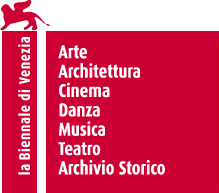56. Biennale – Fabrik

Il progetto Fabrik rappresenta la Germania alla 56. Biennale di Venezia.
Comunicato stampa
„The Pavilion as factory, as a vanished, virtual factory of the imagination, a factory for political narratives and for analysing our visual culture.“
Three months before the opening of the Biennale di Venezia 2015, the artists and curator in Berlin offer an insight into their joint preparations.
The artists involved are Olaf Nicolai, Hito Steyerl, Tobias Zielony, and the artist duo Jasmina Metwaly and Philip Rizk.
Berlin, February 2015 – Instead of a standard press release, curator Florian Ebner has produced a short status report on the progress of the collaborative project up to today:
“In a process that started with approaching the artists and proceeded with conceptual ideas for the work and the initial phases of realization, going right through to the finished exhibition, the Pavilion’s architecture has itself increasingly become the centre of focus.
The German Pavilion has often acted as an artistic echo chamber for German history and identity. This year, the Pavilion’s large, quiet interior with its great height and accompanying sense of volume is a resonant space in which the productive sound of a globalized world can be heard. Starting from their varied reflections on the notions of ‘work’, ‘migration’, and ‘revolt’, the four artistic positions transform the building into a factory, into a vanished, virtual factory of the imagination, into a factory for political narratives and for analysing our visual culture.
The actors who populate the works by Olaf Nicolai, Hito Steyerl, Tobias Zielony, and the artist duo Jasmina Metwaly and Philip Rizk are figures of protest and revolt. We are confronted by these figures in all four works – be they theatrical, photographic, filmic, virtual, and/or physical in nature. The interpretation and usage of the building’s verticality immediately provide a number of different stages for this pavilion of protest and images of resistance: ranging from a kind of basement area all the way up to the roof. It is important too that the roof appears as a heterotope, as ‘another place’, in which freedom is evoked.
Olaf Nicolai puts the roof on show as the setting for a seven-month-long action. His protagonists perform a mysterious activity, a shadow economy enacted under a glistening sun. The choreography of his figures shifts focus between functional actions (or the actual production of an object) and the aesthetic dimension of what is done.
Hito Steyerl’s video installation ‘Factory of the Sun’ shows a world in turmoil and a world of images on the move. It involves the translation of real political figures into virtual figures and an innovative experience of making and engaging with images, somewhere between a documentary approach and full-on virtuality. The new ‘digital light’ is the main medium used to transfer what is left of reality into a circulating digital visual culture.
Tobias Zielony’s documentary essay deals with the situation of African migrants and refugees in Germany. Instead of travelling to Lampedusa, as many journalists (and artists) have done, Zielony dedicates himself to the activist scene in Berlin and Hamburg, tracing out the paths these people have taken, their different fortunes and attitudes. He works with them and with the way they portray themselves, which he then uses as a basis for discussion.
The video installation by Jasmina Metwaly and Philip Rizk is an experimental chamber play in filmic form. For their film project ‘Out on the Street’, the artist duo invited Cairenes, both employed and unemployed, to an improvised studio on the roof of an apartment block, where they were encouraged to tell their own stories of relational power dynamics based on the premise of a factory that has been privatized and wound up.
If nothing else, the Pavilion can be read as a parable for the metamorphosis of visual media, from pictures as classical recordings to the generation, processing, and projection of images. It can also be seen as a statement about the changing use of images, which blurs the boundaries between document, testimony, and fiction.”
To coincide with the opening of the Biennale, a publication is being produced about the German Pavilion 2015 with numerous colour illustrations and contributions from Tom Holert, Marcel Beyer, David Riff, Sarah Rifky, and others.
The German Pavilion team is delighted to have received support from a number of cooperation partners on its journey to Venice. This includes a blog set up by the specialist photography magazine Camera Austria International to address the exhibition themes. The blog, which is administered by national and international authors, will be accessible for the duration of the Biennale on the German Pavilion’s website (www.deutscher-pavillon.org). Our media partners for 2015 are Deutsche Welle, Monopol – Magazin für Kunst und Leben, and Deutschlandradio Kultur.
As coordinator of the German contribution to the Venice Biennale on behalf of the Federal Foreign Office, the ifa (Institut für Auslandsbeziehungen / Institute for Foreign Cultural Relations) was once again able to secure the Sparkassen-Kulturfonds of the German Savings Banks Association (DSGV) as the main sponsor for the German Pavilion.
On top of this, we are pleased to report that we received significant backing last week from the Ruhr area. Three Essen-based foundations – the Alfried Krupp von Bohlen und Halbach-Stiftung, the RWE Stiftung für Energie und Gesellschaft, and the Stiftung Mercator – have provided joint funding for the German entry to the Biennale. The three foundations’ initiative is designed not only to support the concept of the Pavilion but also to increase public awareness of the grand tradition that exists in Essen of promoting photography and the creative genius of the Ruhr area. All three Essen-based foundations have a long tradition of supporting the Museum Folkwang (the professional home of curator Florian Ebner) and its photographic collection and are significantly involved in realizing and facilitating exhibitions, outreach programmes, and new acquisitions and in providing training and grants for artists and researchers.
For the second time since 2013, the German Pavilion is also being funded by the ifa Friends of the German Pavilion / Venice Biennale e.V. 2015.
The Biennale opens at the beginning of May. The German Pavilion will open on Thursday, 7 May 2015. Accreditation for professionals and journalists is only available from www.labiennale.org
Hendrik von Boxberg
Press & PR
Deutscher Pavillon 2015
Linienstrasse 230, 10178 Berlin
0049 177 7379207
[email protected]
Carola Wichert
Press Department
ifa (Institut für Auslandsbeziehungen)
Charlottenplatz 17, 70173, Stuttgart
0049 711 2225 105
[email protected]
www.deutscher-pavillon.org
www.ifa.de
The German contribution to the 56th International Art Exhibition – La Biennale di Venezia is produced on behalf of the Foreign Office of the Federal Republic of Germany and is realized in conjunction with the ifa (Institut für Auslandsbeziehungen / Institute for Foreign Cultural Relations).



